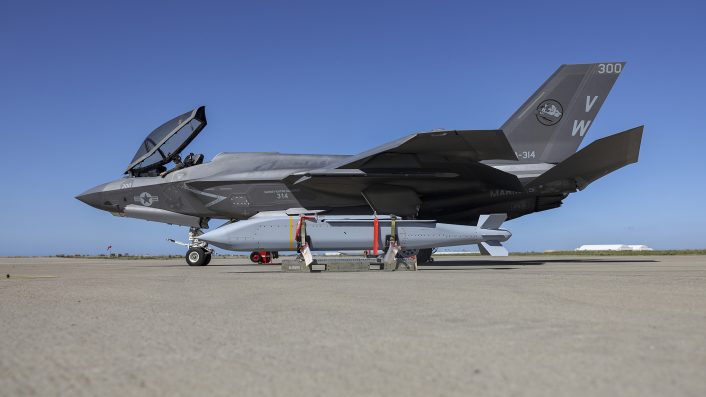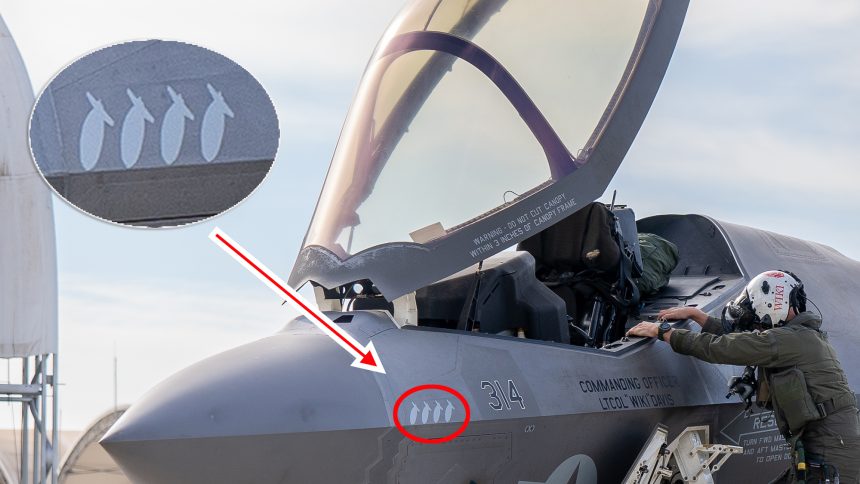The bomb markings on the F-35Cs seem to suggest the “Black Knights” of Marine Fighter Attack Squadron (VMFA) 314 carried out their strikes on Houthi using the JSOW glide bombs too.
The “Black Knights” of VMFA-314 returned to their home base with the 3rd Marine Aircraft Wing at Marine Corps Air Station Miramar following an eventful five-month deployment aboard the Nimitz-class aircraft carrier USS Abraham Lincoln (CVN 72) with Carrier Strike Group (CSG) 3, to the U.S. 7th and 5th Fleet AOR (areas of responsibility), on Dec. 14, 2024.
The squadron, embarked following completion of a four-week composite training unit exercise (COMPTUEX), VMFA-314 deployed with Carrier Air Wing (CVW) 9, on July 11, 2024.
CVW-9 consists of nine squadrons flying the F-35C Lightning II, F/A-18E/F Super Hornet, E-2D Hawkeye, C-2 Greyhound, and MH-60R/S Sea Hawk. Besides the VMFA-314 Black Knights, the squadrons are the “Tophatters” of Strike Fighter Squadron (VFA) 14, the “Black Aces” of VFA-41, the “Vigilantes” of VFA-151, the “Wallbangers” of Airborne Command and Control Squadron (VAW) 117, the “Wizards” of Electronic Attack Squadron (VAQ) 133, the “Raptors” of Helicopter Maritime Strike Squadron (HSM) 71, the “Chargers” of Helicopter Sea Combat Squadron (HSC) 14, and the “Rawhides” of Fleet Logistics Support Squadron (VRC) 40.
According to a press release by the 3rd MAW:
The Black Knights played an instrumental role in supporting U.S. Central Command objectives, participating in dual-carrier operations with the USS Theodore Roosevelt (CVN 71) and supported critical efforts to degrade Iranian-backed capabilities, ensuring the safety of deployed U.S. Forces and deterring regional escalation.
In fact, on Nov. 9-10, 2024, the Black Knights’ F-35Cs conducted multiple strikes on Houthi weapons storage facilities within Houthi-controlled territories in Yemen.
The facilities housed conventional weapons, including anti-ship missiles that the Iranian-backed Houthis used to target U.S. and international military and civilian vessels navigating international waters in the Red Sea and Gulf of Aden.
“The F-35C demonstrated its warfighting advantage by transiting contested airspace and striking targets in the heart of Houthi territory over multiple days,” stated Lt. Col. Jeffrey “Wiki” Davis, commanding officer of VMFA-314. “My Marines are honored to be first to fight with the F-35C.”
“The offensive and defensive capabilities of the F-35C absolutely enhance our air wing’s striking arm,” said Capt. Gerald “Dutch” Tritz, commander, CVW 9. “The now battle-tested Air Wing of the Future has proven itself a game changer across all carrier air wing missions.”
The strikes on Houthi rebels in Yemen, marked the first use of the F-35C Lightning II in combat operations.
“The capabilities and determination of what our team can do amazes me. We made history during our time in the Middle East all due to the tireless work of our Marines and support of the Carrier Strike Group and U.S. forces,” said Lt. Col. Jeffrey Davis, commanding officer of VMFA-314. “This deployment was not easy, and yet the squadron overcame challenging circumstances and continued to set the standard for Marine Corps fixed-wing aviation. We held our steadfast commitment to excellence day in and day out and I will always be proud of their accomplishments. After months of hard work, we are excited to return home to our loved ones.”
The Black Knights, led by their commanding officer, Lt. Col. Jeffrey “Wiki” Davis, and their executive officer, Maj. Nicholas “Pwee” Koza, flew more than 1,400 flight hours across 770 sorties during the five-month deployment. Of these, 195 hours and 61 sorties were in direct support of combat operations in CENTCOM, where the squadron delivered more than 72,000 pounds of ordnance.
No additional detail about the type of ordnance used in combat by the F-35C has been disclosed so far.
Internally, along with the AIM-120 Advanced Medium-Range Air-to-Air Missiles (AMRAAM), the F-35C can currently carry 1,000 and 2,000-pound class JDAMs (Joint Direct Attack Munitions), 500-pound Paveway-series laser-guided bombs, and AGM-154 Joint Stand-Off Weapon (JSOW) fire-and-forget medium-range precision guided weapon.
Noteworthy, the VMFA-314 F-35Cs returning from the deployment, sported some interesting bomb markings, that would seem to suggest that the JSOWs were indeed used in combat by the Black Knights.
View this post on Instagram
The JSOW is a 1,000-pound class weapon that can carry several different lethal packages. It operates by deploying its foldable wings after release, allowing it to glide long distances toward its target using an imaging infrared (IIR) seeker and GPS/INS guidance, making it highly effective for standoff attacks: it has a range of up to 70 nautical miles (130 km) when launched from high altitude, and around 12 nautical miles (22 km) from low altitude.

According to the U.S. Navy, AGM-154C variant incorporates a 500-pound blast/fragmentation/penetrator warhead effective against fixed-point targets such as industrial facilities, logistical systems and hardened tactical targets. The AGM-154C incorporates an uncooled, long-wave imaging infrared seeker with autonomous target acquisition algorithms for precise targeting. The AGM-154C was approved for full-rate production in December 2004 and achieved Initial operational capability in February 2005.
Interestingly, earlier this year, U.S. Marines with VMFA-314 carried out loading activity of live AGM-154s at MCAS Miramar marking the first loading of the weapon system on the F-35C and the first time being loaded in a garrison environment in nearly 20 years.

All that being said, while bomb markings are not always a reliable indicator of the actual weapons used in combat, the silhouettes on the F-35Cs at MCAS Miramar, combined with the use of live AGM-154s during training ahead of the squadron’s deployment aboard USS Abraham Lincoln, strongly suggest that the JSOW was one of the air-to-surface munitions employed in combat by the Lightning IIs of VMFA-314.

Anyway, the F-35Cs of VMFA-312 also employed the GBU-32 JDAMs during the deployment, hence the bomb markings may be a reference to the use of that kind of weapon.
US Marine Corps F-35C Lightning II squadron, VMFA-314, flew 195 flight hours across 61 sorties in support of combat operations in Central Command, where it delivered over 72,000 pounds of ordnance while deploying aboard aircraft carrier USS Abraham Lincoln (CVN-72).
www.dvidshub.net/news/487443/…
[image or embed]
— Ryan Chan 陳家翹 (@kakiuchan.bsky.social) December 15, 2024 at 2:52 PM
USS Abraham Lincoln
During the latest cruise, Abraham Lincoln Strike Group used every opportunity to work with more than 10 allied nations to strengthen joint maritime capabilities. The Black Knights participated in the first bilateral Multi-Large Deck Event held in the Indo-Pacific by the U.S. and Italian Navy on Aug. 9, 2024, and conducted joint flight operations with Italian F-35Bs, showcasing the ease of integration available across the F-35 enterprise.
Actually, the Abraham Lincoln Carrier Strike Group (CSG) and Italian Navy’s ITS Cavour CSG conducted two Multi-Large Deck Event (MLDE), with the second one in the 5th Fleet AOR (Area Of Responsibility), in October. During the latest MLDE, two U.S. Navy F/A-18E Super Hornet, belonging to Strike Fighter Squadron (VFA) 151 and 14, carried out aerial refueling with four Italian F-35B Lightning II and four AV-8B+ Harrier II jets attached to ITS Cavour Carrier Strike Group. Although the Italians had practiced refueling from Super Hornets during Neptune Strike 2022, this was the first time a “package” of eight Italian aircraft were refueled by the U.S. Navy tankers.
The Abraham Lincoln Carrier Strike Group consists of the flagship USS Abraham Lincoln (CVN-72), embarked staffs of CSG-3 and Destroyer Squadron (DESRON) 21, CVW-9, Arleigh Burke-class guided missile destroyer USS Frank E. Petersen Jr. (DDG 121), and DESRON 21’s USS Spruance (DDG 111) & USS Michael Murphy (DDG 112).
Arleigh Burke-class guided-missile destroyers USS O’Kane (DDG 77) and USS Stockdale (DDG 106) remain deployed in the U.S. 5th Fleet area of operations supporting global maritime security operations.









